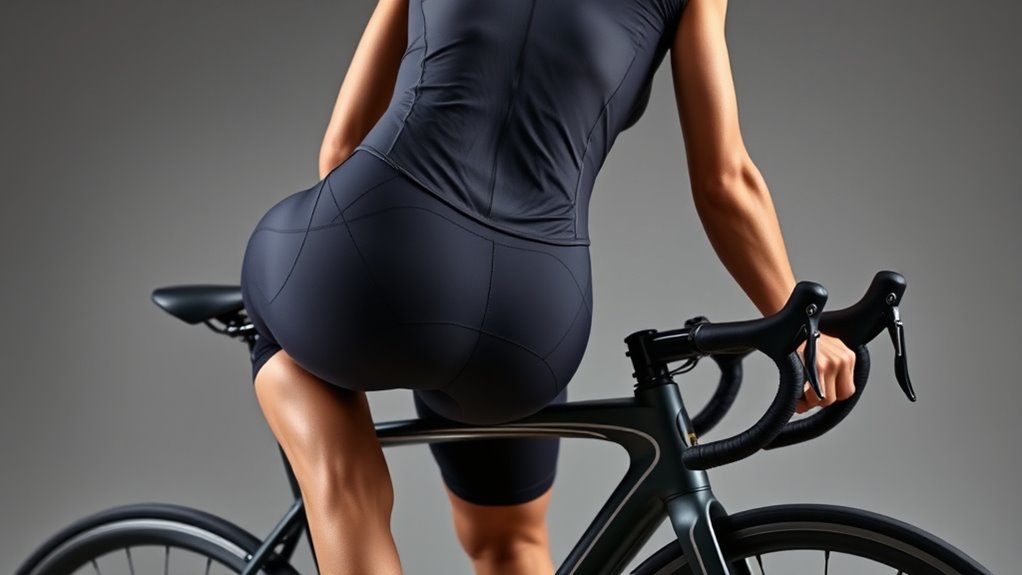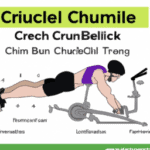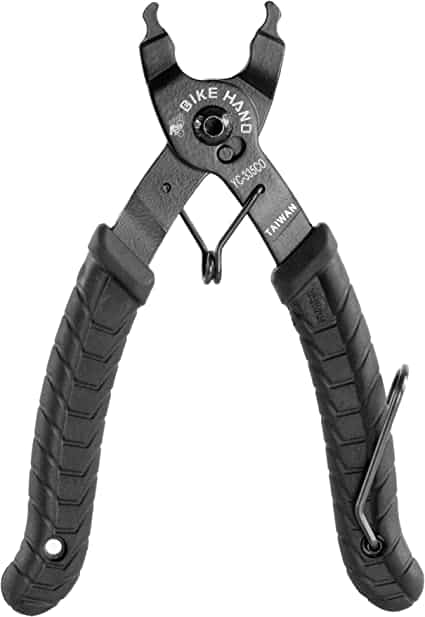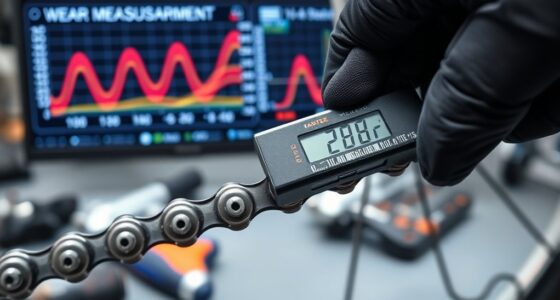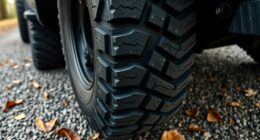Flexibility and core strength play a key role in how well your bike fit works for you. When you have good flexibility, you can adopt natural positions, minimize strain, and make precise adjustments for comfort and power. Strong core muscles help stabilize your body, improve pedaling efficiency, and allow you to handle more aggressive riding postures. As your flexibility and strength improve, your bike fit can be optimized further—keep exploring to learn how to maximize both for better cycling performance.
Key Takeaways
- Greater flexibility allows for more precise bike adjustments, improving comfort and efficiency during rides.
- Improved core strength stabilizes posture, reducing fatigue and enhancing power transfer on the bike.
- Flexibility impacts saddle height, handlebar reach, and cleat positioning, directly influencing bike fit and riding comfort.
- Core stability helps maintain proper spinal alignment, preventing strain and supporting longer, more comfortable rides.
- Regular flexibility and core training enable better adaptation of bike setup as your mobility and strength improve.
The Role of Flexibility in Optimizing Bike Position
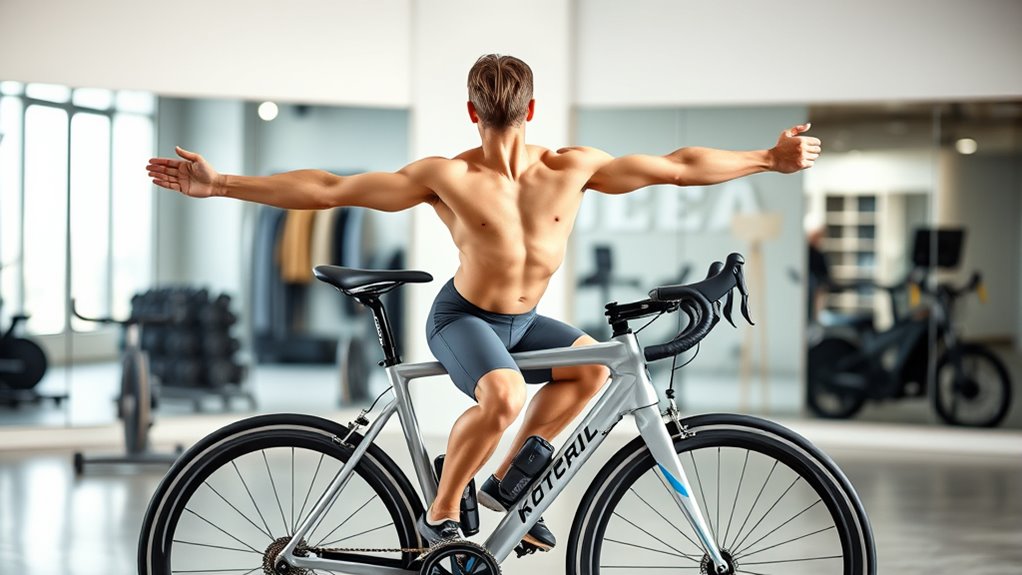
Flexibility plays a crucial role in achieving an ideal bike position because it directly affects your ability to adopt and maintain efficient riding postures.
Flexibility is essential for maintaining optimal, efficient riding postures on your bike.
Tight hip flexors can limit saddle height and tilt adjustments, reducing pedaling efficiency.
Hamstring inflexibility makes it harder to keep a flat back, increasing upper-body strain.
Thoracic spine rigidity compromises handlebar reach, forcing awkward shoulder and neck positions.
Poor ankle mobility disrupts cleat alignment, leading to uneven power transfer.
Limited lumbar mobility prevents proper saddle fore-aft adjustments, altering hip angles.
These restrictions also influence handlebar drop, saddle setback, and cleat positioning, often forcing you to compensate with suboptimal setups.
Improving flexibility allows for more precise adjustments, maximizing comfort, efficiency, and performance on your bike.
Additionally, enhancing joint mobility can contribute to better airflow and breathing, which supports sustained effort and endurance during rides.
Incorporating regular stretching routines can help maintain or improve overall joint mobility, making it easier to achieve optimal bike fit and comfort.
Engaging in targeted flexibility exercises can help alleviate these restrictions and improve your overall pedaling efficiency, leading to a more comfortable ride.
A focus on core strength can further support proper posture and reduce strain during long rides.
How Core Strength Enhances Stability and Power Output
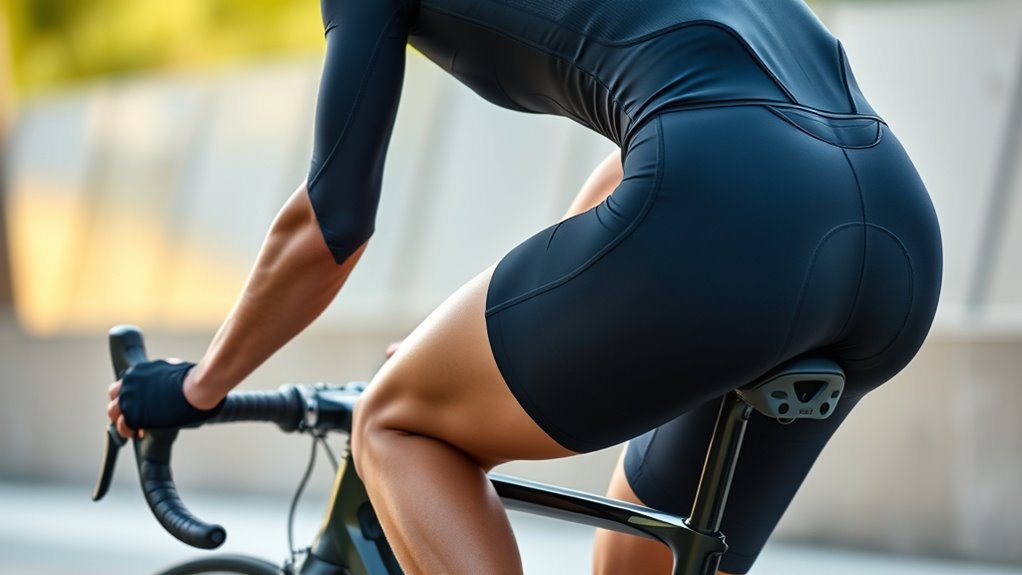
A strong core forms the foundation for stability and power during cycling. Your core muscles—abs, back, hips, and pelvic floor—stabilize your trunk and spine, helping you maintain proper posture and reduce fatigue. Proper costume selection can also enhance confidence and comfort during long rides or events. A solid core links your upper and lower body, optimizing force transfer during pedaling and preventing excessive torso movement, especially during sprints. This stability minimizes energy leaks and enhances force application through crank rotation, making your pedal strokes more efficient. It also reduces compensatory movements like hip rocking, which can waste energy. Vetted core training methods such as compound lifts and anti-rotation drills into your training boost your core strength, directly translating to improved stability and increased power output on the bike. Additionally, understanding the trustworthiness of AI models can inform the development of personalized training programs that adapt to your progress and needs. Moreover, incorporating somatic awareness practices can help cyclists better feel their body’s signals, leading to more effective training and injury prevention.
Adjusting Your Bike Setup Based on Flexibility and Strength

Your bike setup should directly reflect your body’s flexibility and strength to guarantee both comfort and peak performance. If you have limited shoulder and back flexibility, a more upright handlebar position can help reduce strain. Incorporating Halloween-themed accessories can also boost your ride’s visual appeal during festive events. Conversely, strong core muscles enable you to lower the handlebars for a more aerodynamic posture without sacrificing stability. Adjust handlebar height by considering your ability to reach comfortably and maintain control. When it comes to saddle placement, your leg length and flexibility influence saddle height and fore-aft position. Digital literacy programs can enhance your understanding of proper bike fitting techniques, especially for seniors or those new to cycling. Core strength helps you stay stable on longer rides, so don’t hesitate to fine-tune your saddle to reduce lower back discomfort. Regularly assess and adapt your setup as your flexibility and strength improve to optimize comfort and efficiency.
The Impact of Flexibility and Core Fitness on Cycling Performance

Enhanced adaptability and core fitness substantially boost cycling performance by improving posture, stability, and power transfer. When your core is strong, you maintain better posture on the bike, reducing energy waste and allowing more efficient power delivery.
Improved neuromuscular stability minimizes unnecessary movements, decreasing fatigue in secondary muscles during long rides. Flexibility in the hips, thoracic spine, and ankles enables ideal pelvic positioning, handlebar reach, and pedal mechanics, enhancing efficiency and reducing discomfort.
A flexible, strong core also stabilizes your upper body, minimizing oscillations that waste energy and cause soreness. These gains translate into better muscle recruitment, increased endurance, and reduced injury risk.
Training Strategies to Improve Flexibility and Core Strength for Better Fit
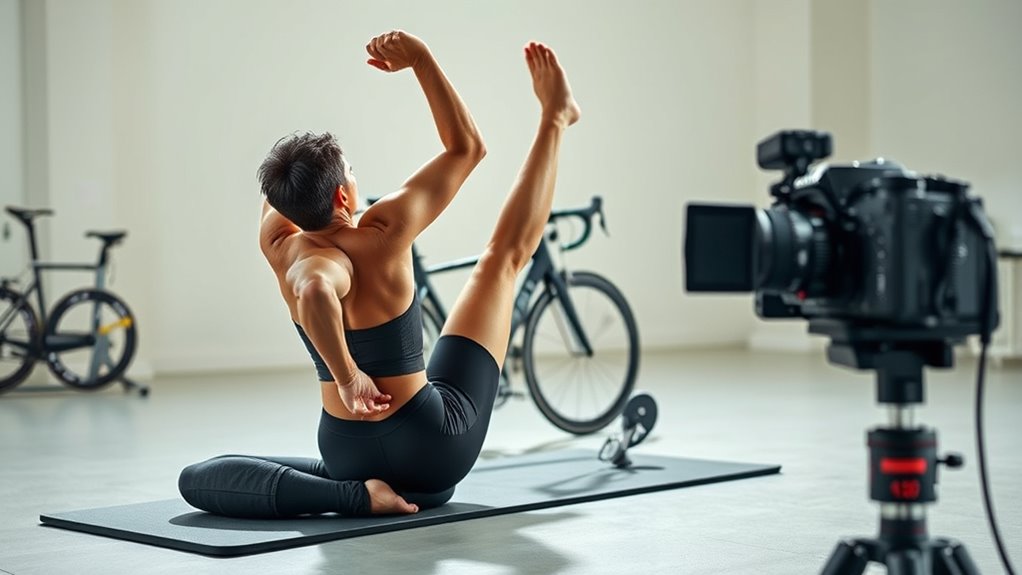
Implementing targeted training strategies can substantially improve your flexibility and core strength, leading to a better cycling fit.
Targeted training improves flexibility and core strength for a better cycling fit.
To boost flexibility, incorporate static stretches after rides, focusing on hips, hamstrings, and your lower back, like the Figure-Four Stretch. Yoga sessions enhance joint mobility and reduce upper-back tension from aggressive riding postures.
Use primal squat stretches and foam rolling to release tight muscles in the quads, IT bands, and calves. Consistency is key—regular stretching over months yields meaningful gains.
For core strength, include planks and dead bugs to stabilize your lower back, while rotational exercises like Russian twists improve torso stability. Dynamic bridging activates glutes and hamstrings, and anti-rotation moves like Pallof presses boost resistance to sway.
Integrate breathwork to enhance spinal stability during these exercises.
Practical Tips for Assessing and Improving Your Bike Fit
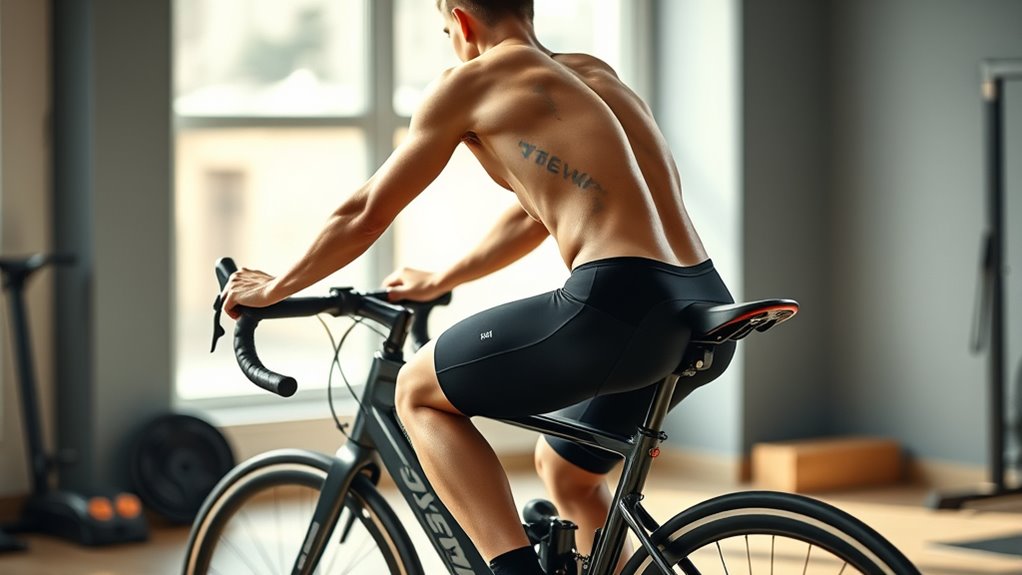
Evaluating and improving your bike fit starts with understanding key measurements and adjustments that can optimize comfort and performance.
Begin by measuring your inseam: stand against a wall, place a book between your legs to simulate saddle height, mark the wall, then measure from that mark to the floor.
Check standover height for adequate clearance when standing over the bike.
Adjust your saddle so your knee forms a 25°–35° angle at the pedal’s lowest point.
Ensure your upper body has a slight bend in your arms without overreaching.
Regular mobility exercises can enhance flexibility, making adjustments easier and more effective.
Use adjustable components like handlebars and saddles for fine-tuning.
Consult a professional fitter if needed, and reassess your fit periodically to accommodate changes in flexibility and strength.
Frequently Asked Questions
How Often Should I Reassess My Bike Fit for Flexibility and Core Strength?
You should reassess your bike fit at least once a year as a baseline. However, if you experience significant fitness or mobility changes—like injuries, flexibility gains, or post-physical transformations—you’ll want to check more often.
Also, monitor for issues like reduced hamstring or hip flexor range, shoulder stiffness, or saddle discomfort. Regular evaluations ensure your bike fit stays ideal, supporting comfort, performance, and injury prevention.
Can Poor Flexibility or Core Strength Cause Long-Term Injury Risks?
Poor flexibility or core strength can definitely increase your long-term injury risks. When your muscles are tight or your core isn’t strong enough, it forces your body into unnatural positions, putting extra strain on your back, knees, and hips.
Over time, this can lead to overuse injuries like tendinitis or chronic pain. Addressing these issues with regular stretching and core exercises helps prevent these injuries and keeps you cycling safely.
What Are the Best Exercises to Improve Cycling-Specific Flexibility?
You might think stretching won’t considerably boost your cycling, but targeted exercises really do improve flexibility for better performance. Focus on hip flexor lunges with trunk twists and couch stretches to open hips and quads.
Incorporate hamstring stretches like downward-facing dog and forward bends, along with spine openers like camel pose. These moves enhance your range of motion, helping you stay comfortable and efficient on the bike.
How Does Age Affect Flexibility and Core Strength in Bike Fitting?
As you age, your flexibility tends to decline, making it harder to maintain comfortable, aggressive bike positions.
Your core strength also diminishes, affecting your posture and stability on the bike.
You’ll need to adjust your bike fit regularly to stay comfortable and prevent injuries.
Incorporating stretching and core exercises helps, but professional fittings can guarantee your bike setup adapts to these natural changes, keeping you riding smoothly.
Are There Specific Stretches or Workouts Recommended for Cyclists?
Think of your body as a finely tuned machine that needs regular tuning to perform at its best. For cyclists, specific stretches like kneeling lunges and calf stretches loosen tight muscles, boosting your pedal power.
Strengthening workouts like bridges and pelvic scoops build a resilient core, supporting your posture and reducing fatigue.
Incorporate yoga poses and mobility drills to keep your body flexible and ready for every ride, making your cycling smoother and more efficient.
Conclusion
By focusing on flexibility and core strength, you can transform your bike fit and ride with greater comfort and power. Think of it as tuning your trusty steed — like a knight preparing for battle. Regular training and adjustments will keep you nimble and strong, ensuring every pedal stroke counts. Remember, a well-balanced bike fit isn’t just a myth — it’s the secret weapon for cycling success that even a medieval knight would envy.
